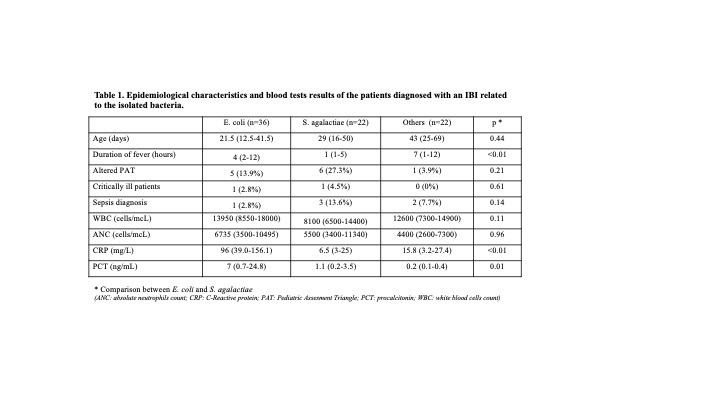Emergency Medicine: All Areas
Emergency Medicine 3
50 - Markers for invasive bacterial infection in young febrile infants related to the causing bacterium
Publication Number: 50.112

Roberto Velasco, MD PhD (he/him/his)
Pediatric Emergency Physician
Hosp. Univ. Río Hortega
Laguna de Duero, Castilla y Leon, Spain
Presenting Author(s)
Background:
The performance of blood biomarkers for identifying an invasive bacterial infection (IBI) in children varies related to the isolated bacterium. However, no study has analyzed this variation among young infants, in whom E. coli and S. agalactiae are the most commonly isolated bacteria.
Objective:
To analyze the biomarkers' profile in young febrile infants who are evaluated in the ED and finally diagnosed with an IBI.
Design/Methods:
We conducted a secondary analysis of a prospective single-center registry that includes all consecutive infants ≤90 days of age with FWS who have attended a pediatric emergency department (PED) between 2008 and 2021.
We considered IBI when a pathogen bacterium was identified in blood and/or cerebrospinal fluid (CSF) (culture or polymerase chain reaction) and critically ill patients those requiring emergent interventions such as cardiopulmonary resuscitation, endotracheal intubation or inotropes.
Results:
Among the 2869 registered infants, 84 (2.9%) were diagnosed with an IBI (76 bacteremia, 4 meningitis and 4 meningitis with associated bacteremia). E. coli (36; 42.8%) and S. agalactiae (22; 26.1%) were the most frequently causing bacteria. Table 1 shows the epidemiological characteristics and blood tests results of the patients diagnosed with an IBI related to the isolated bacteria.
After adjusting for possible confounding factors, such as age and hours of fever, infants with E. coli showed significantly higher CRP values than those with S. agalactiae (b= 107.2; CI95%: 8.7 to 205.7). Those differences were not found in PCT values (b= 55.2; CI95%: -26.7 to 137.1).
Conclusion(s):
Our results suggest that biomarkers' profile in young febrile infants with an IBI varies depending on the causing bacterium and seems to be influenced by the specific host inflammatory response to each one. 
